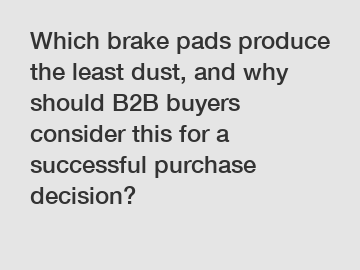Dec. 22, 2023
Transportation
In the fast-paced world of automotive manufacturing and maintenance, making the right purchasing decisions can significantly impact the success and efficiency of businesses. When it comes to brake pads, professionals must consider various factors, with dust production being a crucial aspect. While safety remains paramount, dusty brake pads can lead to numerous issues. In this blog, we explore which brake pads produce the least dust and delve into why B2B buyers ought to prioritize this factor for a successful purchase decision.
The Dust Dilemma:
Brake pad dust emerges as a natural byproduct of friction between the pad and the rotor during the braking process. Over time, this accumulation can stain wheels, negatively affecting a vehicle's aesthetics. Additionally, excessive dust may find its way into delicate mechanical components, potentially compromising their functionality. In a B2B context, such issues can lead to increased maintenance costs, time-consuming cleanings, and even reputation damage. It is vital, therefore, to identify brake pads that contain dust effectively.

Low-Dust Solutions:
1. Ceramic Brake Pads:
Ceramic brake pads have gained popularity in recent years due to their impressive ability to produce significantly less dust compared to traditional alternatives. These pads utilize advanced formulations that prioritize ceramic fibers and composite materials, resulting in decreased wear and friction. Consequently, the minimal dust production offered by ceramic brake pads ensures cleaner wheels, easier maintenance, and reduced environmental impact.
2. Low-Metallic Formulations:
Like their ceramic counterparts, low-metallic brake pads provide an excellent alternative for B2B buyers seeking dust reduction. These pads employ a blend of organic materials and a reduced metal content, which results in decreased brake dust formation. While they may generate more dust compared to ceramics, low-metallic brake pads still offer a substantial improvement when compared to semi-metallic or metallic options, making them worth considering for businesses seeking a cost-effective yet efficient solution.
3. Copper-Free Brake Pads:
Brake pads often contain copper, which aids in friction and heat dissipation. However, the use of copper can contribute to increased dust production and, consequently, environmental concerns. As an eco-conscious choice, copper-free brake pads are gaining traction in the market. These pads employ alternative materials that maintain excellent braking performance while significantly reducing dust emissions, making them an ideal choice for businesses aiming to strike a balance between productivity and sustainability.
Further reading:Why B2B Buyers Should Prioritize Less Dust:
1. Maintenance Efficiency:
By opting for brake pads that produce minimal dust, B2B buyers can reduce the time and effort invested in frequent wheel cleaning. Clean wheels not only enhance the appearance of vehicles but also streamline maintenance processes, allowing businesses to focus on more critical tasks and achieve higher productivity levels.
2. Vehicle Longevity:
Reduced brake pad dust offers benefits beyond the cosmetic realm. By minimizing dust accumulation in mechanical components, businesses can safeguard critical parts of the braking system from potential damage. This can lead to increased vehicle longevity, fewer breakdowns, and reduced repair costs, ultimately enhancing the overall operational efficiency.
3. Environmental Considerations:
With an increasing emphasis on sustainable practices, businesses that prioritize low-dust brake pads demonstrate their commitment to reducing environmental impact. Not only does this resonate positively with socially conscious consumers, but it also positions B2B entities as responsible contributors to a cleaner, greener future, boosting their reputation and potentially opening up new business avenues.
Conclusion:
In the world of B2B brake pad procurement, prioritizing the least dust-producing options is a wise decision. By opting for ceramic pads, low-metallic formulations, or copper-free alternatives, businesses can minimize maintenance efforts, enhance vehicle longevity, and showcase their commitment to sustainability. As B2B buyers consider these factors, they elevate their purchasing decisions to accelerate success, improve efficiency, and contribute towards building a cleaner and more responsible automotive industry.
Are you interested in learning more about low-metallic brake pad supplier, brake pads manufacturers in china, OEM Passenger Car Semi-metallic Brake Pads? Contact us today to secure an expert consultation!
Further reading:Related Articles
If you are interested in sending in a Guest Blogger Submission,welcome to write for us!
All Comments ( 0 )